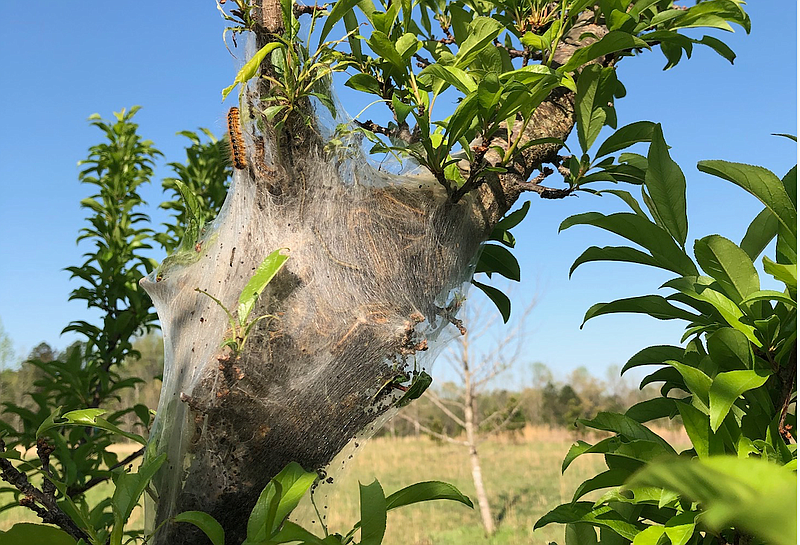Have you noticed colorful caterpillars on your wild cherry, apple or crabapple trees recently?
There’s a name for them, apiculture instructor Jon Zawislak at the University of Arkansas System Division of Agriculture said: the eastern tent caterpillar.
The critters were named for the silk tents they build, usually in the forks of tree branches, Zawislak said. They hide in the tents in communal groups, coming out to feed several times a day, he added.
The species is native to North America, with populations tending to fluctuate each year. Large spring outbreaks occur every several years, Zawislak said.
The University of Arkansas System Division of Agriculture posted on Facebook on Tuesday that the research center was getting “tons” of questions about the insects.
In the post, Zawislak assured readers that although the bugs' nests and the trees they strip of leaves can be unsightly, the plants are often OK.
“They can defoliate and significantly stress young trees, but mature trees are rarely harmed, and will regrow new leaves,” he said.
Nests may also be found on hawthorn, maple, cherry, peach, pear and plum trees, among others.
Myles Overton, whose family owns property in Montgomery County, recently noticed silk tents built by eastern tent caterpillars in his trees.
Overton said it's the first time he has ever noticed them, and they were hard to ignore because they were in several of his trees.
As the caterpillars grow, Zawislak said, they will expand their nests. Typically in their final stage of six life stages, they will only eat at night and begin to leave the nest to find a safe place to build their cocoons. This is most likely when people will encounter them, he said.
An adult moth can be expected to emerge from a cocoon in up to two weeks. Once out of the cocoon, Zawislak said these adult moths live short lives, dying soon after they lay eggs.
Each egg mass typically contains anywhere from 150 to 400 eggs, which will lay dormant until the next spring. Zawislak said homeowners may choose to prune areas where they see egg masses in early summer, cutting down on the number of caterpillars the following spring. Homeowners can prune infested limbs of the trees to remove the silk tents, or opt to treat with Bacillus thuringiensis (commonly referred to as "Bt"), an insecticide that Zawislak said is specific to caterpillars. It must be consumed on foliage, and he said it might be harmful to some butterfly species.
Overton removed the tents and caterpillars in his trees by hand, he said.
"I had a glove; they were in reach. Although it was pretty gross, I took them out by hand," he said. "They were pretty aggressive, because once I took the webs out, it was like reaching into a pack of snakes."
The caterpillars, which Overton said ate a healthy amount of the leaves on the trees, were already crawling up the tree limbs again once the tents were removed, he said.
Birds don’t typically eat eastern tent caterpillars because of unpalatable hairs on their bodies, Zawislak said, adding that dogs and cats probably wouldn’t find them appetizing, either.
He said insects that advertise their presence, like the eastern tent caterpillar does with its bright colors, are probably not afraid of being eaten.
It is safe for kids to pick them up and play with the bugs, but the risk is the insects being squeezed or dropped, he said.
